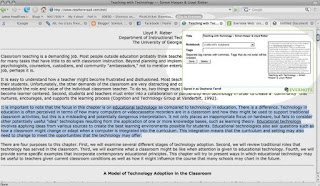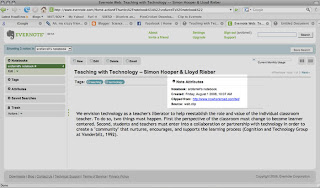I was talking with my I.T. guy (aka, my husband) about Furl as an option for clipping websites, articles, etc for future reference. He asked me if I had checked out Evernote.
So, I went. On the surface, it seemed to be a bit like Furl, offering website clipping and tagging, easy search features, etc. And it doesn't have Furl's community features "most tagged," "share with others," and so on.
But here's what it does have: integration. Multiple forms of media. Smart searches. You can take a picture with your phone, email it to yourself, it will read any text in the image and in future searches through your Evernote "notebook" those images will also appear. Imagine - take a picture of a complicated image drawn on a whiteboard, save it, tag it, and search for it later (either by tag or by searching for text in the image itself). SWEET!With Furl, you clip the whole webpage. You can highlight a quote from it and include it in your information when you save the page. Evernote takes it a step farther - highlight the text in the page, use your "Clip to Evernote" tool, and it saves just that quote for you, saving the URL in the "Note Attributes" (highlighted below).

 This is a great feature if you're doing a lot of research for a paper and you just need to save some references or quotes. I definitely appreciate it because I have a hard time absorbing large amounts of information from a screen. I still want to print out a hard copy and use a highlighter. But I can't search that. Here, I'm essentially doing the same thing and now my 'highlighted' notes can be tagged, saved and searched.
This is a great feature if you're doing a lot of research for a paper and you just need to save some references or quotes. I definitely appreciate it because I have a hard time absorbing large amounts of information from a screen. I still want to print out a hard copy and use a highlighter. But I can't search that. Here, I'm essentially doing the same thing and now my 'highlighted' notes can be tagged, saved and searched.
I'm going to keep both Furl and Evernote around to see how they work in the longterm. But for now, I have to say that Evernote is more impressive to me. The user interface is more attractive and easier to use. The media integrations and ability to use it from cell phone or email, not just browser, are exciting and useful features. Try it out!

Bookmarking tools are useful for any researcher, or research-based profession. The Internet is not only a wealth of information, but can be an overwhelming source of information. Trying to sort through all of the results of a search, or even just the countless daily headlines available as more and more local newspapers 'go live' with their own websites can be a daunting task. As a science teacher, it is important for me to stay up-to-date on new discoveries, research and technology. Often, I read a good article, and want to remember to apply it a class later, but can't remember where I found it. Thanks to social bookmarking sites like Furl, this becomes significantly easier.
The Pros: In my previous post, I talked about how it's great that iGoogle (and RSS feeds in general) will search out the newest headlines on any topic of my choice. Here is the tool that I can then use to save them, so that even as they're replaced in a feed by newer headlines, I can still access them, tagged and annotated to help sort for relevancy. Furl, with it's quick and easy toolbar add-on, makes it easy to save something now and come back to it when I have time. And you never lose an article - because Furl archives a complete copy of the page's html, it can't be lost due to outdated or broken links. Also, easy tagging with topics/keywords for future searching is a big bonus. In terms of using technology for teaching, this isn't a bad way to find articles to assign for additional reading.
The Cons: It may seem petty, but I find the site visually unappealing. I feel like I'm reading a bunch of Google text ads and not a list of my favorite articles. This is an important reminder: you can have the most relevant, useful, high-quality content and usability out there, but if your website isn't appealing, the negative associations destroy what you've set out to do.
That's not to say I won't use it. I'm sure I can adjust to the layout in time. Certainly as a tool for tracking articles for future reading and reference, it has a valuable place in teaching.
References: Furl.net, Wikipedia:Furl

 This is a great feature if you're doing a lot of research for a paper and you just need to save some references or quotes. I definitely appreciate it because I have a hard time absorbing large amounts of information from a screen. I still want to print out a hard copy and use a highlighter. But I can't search that. Here, I'm essentially doing the same thing and now my 'highlighted' notes can be tagged, saved and searched.
This is a great feature if you're doing a lot of research for a paper and you just need to save some references or quotes. I definitely appreciate it because I have a hard time absorbing large amounts of information from a screen. I still want to print out a hard copy and use a highlighter. But I can't search that. Here, I'm essentially doing the same thing and now my 'highlighted' notes can be tagged, saved and searched.